Day to Day Life
Messages: In America, the best way to send a message, increase social awareness, or brand a concept/gadget is through mass media using television, radio, and newspapers with ancillary outputs on social media, posters/signs, motivational talks, school text books, pamphlets and web sites. Of course a good celebrity spokesperson on the payroll is helpful. It costs a great deal of money to run a campaign, so a lot of effort is put into getting as much free media as possible until the message becomes a mainstream thought process and standard education presentation. (Examples: Smoking is bad for you. Milk is good for you. Bullying is bad. Responsible sexual behavior is good for everyone). We use community events to get the free media – but the big emphasis is on building a consistent simple message that can be heard and seen by many people as many times as possible. A community event without the media is consider a costly and unproductive use of time and resources.
In Botswana, TV is almost never used as a way to educate. Many people don’t have TV’s and when they do, programs are presented in multiple languages in small geographical areas and it is hard to broadcast to some of the most needy areas that speak minority languages .
Community Events are the preferred method of communication as well as the primary method to advocate for social change. Most events require a four or five hour long program that includes many speakers, most of them dignitaries (Kgosi or chief, police, a few people from the pertinent Ministry, and a couple of people who planned the event). There is almost always traditional dancers, and dramas (skits). Serving tea is a minimum requirement and if tea is not served NO ONE will come. It is very good to serve lunch too. If you have lunch and tea you can usually guarantee a crowd or 30 or 40 people.
These events often remind me of political events in America. The only people who want to discuss the issue or attend an event about the issue are those that know everything about the issue and are usually paid to advocate for the issue. Other people in attendance are somehow compelled to attend through friendship or employment and don’t need or want to be educated. The room is filled with people from the choir.
I’m not sure why the community village meeting is the most used process for education, when it is fairly clear it has a minimal effect. I suspect one of the biggest reasons is that people from outside the community and often the country are the people who want to educate a local population and everyone is up for a community meeting when employment is high and food is low. So many international organizations send money to help train and educate poor people, and complicated programs are rarely enacted. Nearly anyone can put together a 4 or 5 hour program, that includes 30 to 100 people who get two free meals. Food is always served at these events. A community event is something that is easy to report some basic outputs (attendance), and many outside educators/developers have given up on attempts to measure real long term outcomes (changed behavior). It is also fairly gratifying seeing a bunch of people at a community event – until you realize these events are often a standard community get-together and not some incredible educational program one was able to pull off.
I don’t believe it is efficient, nor do I think it is the best way to spend value resources. However, it does add some value. Anytime a message is repeated, it becomes a little more ingrained, and people often bring their small children who may hear the message for the first time. We PCV’s are generally good at planning community events and we often end up doing a great deal of this sort of work. John and I have supported, attended or developed several such events with Peace Corps volunteers in or around my community. I thought I would post pictures of a few – they are all generally the same.
International Women’s Day: The purpose of the event was to educate people that they can have an impact in reducing gender violence. This event was not as structured as most and had a few games and some activities for kids to play. However, it did have the standard skit and the speakers. Because the event deviated from the standard agenda it was hard to get some things off the ground – and I was glad when it still started after being delayed for 3 hours. The highlight was asking children to say what they would do to end gender violence and then have them put their hand print on a memory board to be used at future events.
*If you go to the actual web site and double click the pictures you can see them full size.

The drama – or skit that is developed to deliver the message. This drama was about the evils of domestic violence and how to get help.
Alcohol and Drug Education: This country has a huge problem with alcohol abuse, which many believe directly effects the spread of HIV/AIDS. A couple of years ago the country put a huge (10% – huge to them) tax levy alcoholic beverages. Funds are distributed to schools who put in applications and one of my friends had a six hour long event with both tea and a nice lunch. She was able to convince several of her PCV friends to stay in her village and play organized games with all the children after the event. She also had a PCV lead a community project to paint a mural on a school wall showing the dangers of alcohol abuse.

The events often start with a march that goes from a couple of blocks to a couple of kilometers. But no one ever lines the road to watch or cheer. However – if one is in a car or walking by, the person will usually try and find out the purpose
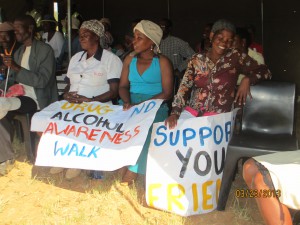
The commuity listens/watches the event unfold under tents. They have incredible endurance and can sit through hours and hours of presentations.

Dana is the PCV artist and has done murals around the country that leave a message about alcohol abuse.
GED; called BOCADOL in Botswana: I have mentioned Springboard Humanism as an NGO (Not-for-profit) organization where I teach Commerce and English to extremely disadvantaged teens. Springboard is a start up organization and has been trying to raise funds for the program since I got here. The organization recently received a large grant from Barclay’s Bank and are now tutoring 16 highly motivated students to complete their secondary education classes. When it got the grant they put together a program to highlight the needs to provide an education to each student in the country.
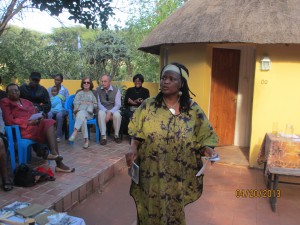
Kelone is the original founder. She also works as a professor, teaching art at Botswana University. She brings children from her home village to live at her home/NGO to obtain an elusive education.

The owners are asking one of their first students to come talk about how their NGO is helping her meet her goals.
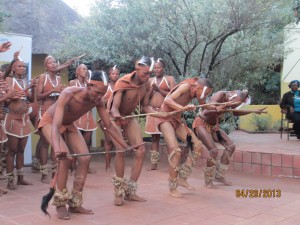
The traditional dancers. Children start learning this in grade school and there are hundreds of clubs of adults who continue this tradition all their lives. Many times older people from the crowd will get up and join in – they are always welcome on stage.
When American’s come here we all want to teach local people how to turn a grinding 6 hour long public service announcement into a fun community event for a broader audience as well as different way to learn about a message. Eventually we learn, they will not tolerate a band, booze, movement and 5 camera’s/microphones. A successful event is defined as one that 50 or more people attended and there was plenty of food. We learn to sit and listen and be respectful to those who have something to say.
It is very different than how we “message” in America. I am hoping we (P’CV’s) are adding value in tiny unseen increments to improve the message. I also hope I am learning something about quiet and respect that benefits me and has a value when I return to America.
Time will tell.

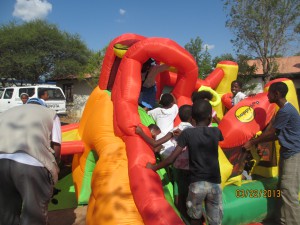
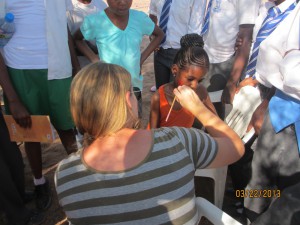

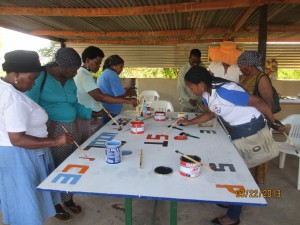



 Gaborone Time
Gaborone Time